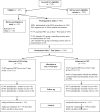A randomized clinical trial of a palmtop computer-delivered treatment for smoking relapse prevention among women
- PMID: 21500879
- PMCID: PMC5034355
- DOI: 10.1037/a0022797
A randomized clinical trial of a palmtop computer-delivered treatment for smoking relapse prevention among women
Abstract
Relapse is the rule rather than the exception among smokers attempting to quit, and compared to men, women may have higher relapse rates. The current study was a randomized clinical trial testing a palmtop computer-delivered treatment (CDT) for smoking relapse prevention among women. The intervention was individualized based on key theoretical constructs that were measured using ecological momentary assessment (EMA). All participants (N = 302) received standard smoking cessation treatment consisting of nicotine replacement therapy and group counseling, and completed EMA procedures for one week after quitting. At the completion of the group counseling sessions and EMA procedures, participants were randomized to either CDT or no further computer-delivered treatment or assessment (EMA-Only). CDT participants received a palmtop computer-delivered relapse prevention treatment for one additional month. CDT did not improve abstinence rates relative to EMA-Only. Process analyses suggested that heavier smokers were more likely to use CDT and that greater use among CDT participants may be associated with more positive outcomes. The rapid pace of technological advances in mobile computer technology and the ubiquity of such devices provide a novel platform for developing new and potentially innovative treatments. However, the current study did not demonstrate the efficacy of such technology in improving treatment outcomes.
(PsycINFO Database Record (c) 2011 APA, all rights reserved).
Figures
References
-
- Bandura A. Social Foundations of Thought and Action. New Jersey: Prentice Hall; 1986.
-
- Brandon TH, Tiffany ST, Obremski KM, Baker TB. Postcessation cigarette use: the process of relapse. Addictive Behaviors. 1990;15(2):105–114. - PubMed
-
- Carroll K. Relapse prevention as a psychosocial treatment: A review of controlled clinical trials. Experimental and Clinical Psychopharmacology. 1996;4(1):46–54.
-
- Carter B, Day S, Cinciripini P, Wetter DW. Where are we and where are we going? The Science of Real-Time Data Capture: Self-Reports in Health Research. New York: Oxford University; 2007. Momentary health interventions; pp. 289–307.
Publication types
MeSH terms
Grants and funding
LinkOut - more resources
Full Text Sources
Medical
Research Materials



